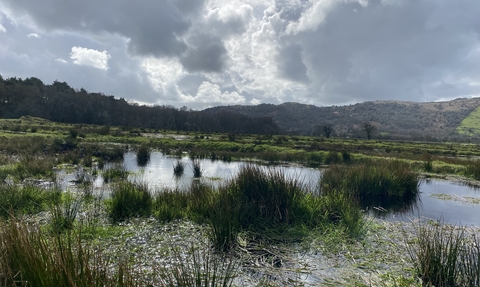
Nichols Moss
Where: Nichols Moss is a part of the Witherslack mosses, located just North of Grange-over-Sands in the South East Lakes.
Restoration area: 4 hectares
Landowner: Cumbria Wildlife Trust
Conservation status: Site of Special Scientific Interest (SSSI), Special Area of Conservation (SAC)
Restoration cost: £83,000
The problem: A large drainage ditch separated the raised bog from a grazed field, which was drying out the peat contained in the bog, as well as several metres of peat beneath the surface of the field. The drying bog edge was allowing encroachment of plant species that prefer drier ground such as bracken, birch and pine. This in turn leads to further drying out of the peat, releasing CO2 into the atmosphere, sediment into the waterways, and reducing the bogs capacity to store water, increasing flood risk in the area.
What Cumbria Wildlife Trust did: Cumbria Wildlife Trust undertook detailed surveys enabling us to accurately map all the erosion features, including the use of high-resolution aerial photographs. This information was used to produce a detailed restoration plan with full costings. The plan was split into two phases; Phase 1 involved addressing the issues with bog edge and the area of deepest peat within the field; Phase 2 involved creating a lag habitat in the field where there was less peat, to protect the hydrology of the bog and deeper peat areas.
Phase 1 two started with clearing the encroaching brash and trees that were spreading along the bog edge, this allowed the creation of bunds on the bog edge and the damming of the deep (>2m) ditch that ran along the bog edge. Following this the deep peat within the field was exposed by removing the top ~15m of nutrient rich turf and creating a series of deep trench cell bunds. Sphagnum plugs were then added to the exposed peat and pools that formed within the cell bunds.
Phase 2 involved the breaking of a series of field drains and creating similar deep trench cell bunds. Planting of fen species will then happen with the help of volunteers within this area to create a habitat that reduces water loss from the adjacent areas of deep peat. Volunteers will also help planting bog species within the deeper peat areas, and across the bunds.
Benefits: Peatland restoration at this site will reduce the Carbon Dioxide loss from the peat due to it drying out and over time will begin to sequester carbon as the rewetted peat begins to grow sphagnum mosses. It will also reduce the water loss from the bog in times of high rainfall, lowering the flooding impact downstream. Raising the water table and making the area wetter will also help a host of rare species that need wet habitats.
Species benefitting: Sphagnum moss, heather, common cottongrass, hare’s-tail cottongrass, crowberry, bilberry, cranberry, bog rosemary, sundew, purple moor-grass, soft rush and a variety of sedge species. Snipe and Little Egret have already been seen using the newly-created pools in the fen area.
Take a look at our other peatland restoration projects
- Borrowdale Moss Peatland Restoration (https://www.cumbriawildlifetrust.org.uk/borrowdale-moss-peatland-restoration)
- Bampton Common Peatland Restoration (https://www.cumbriawildlifetrust.org.uk/bampton-common-peatland-restoration)
- Shap Fells Peatland Restoration (https://www.cumbriawildlifetrust.org.uk/shap-fells-peatland-restoration)
- Tebay Common Peatland Restoration (https://www.cumbriawildlifetrust.org.uk/tebay-common-peatland-restoration)
- Armboth Fell Peatland Restoration (https://www.cumbriawildlifetrust.org.uk/armboth-fell-peatland-restoration)







